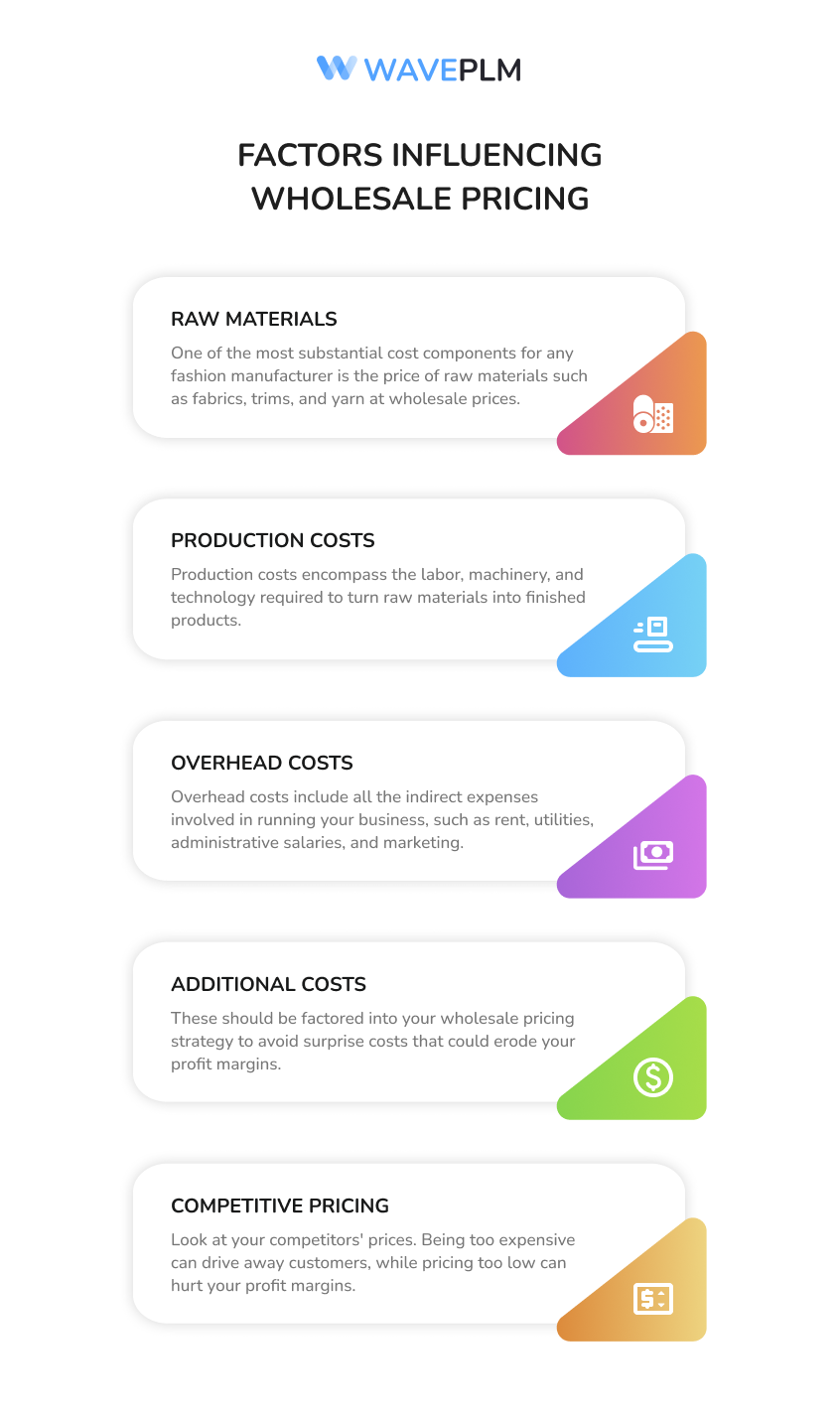
Wholesale pricing is crucial in fashion businesses, especially in manufacturing and supply chain management. Pricing your products correctly ensures profitability while maintaining competitiveness in the market.
This article will guide you on how to calculate wholesale price, including the essential factors and formulas you need to create sustainable pricing strategies.
Understanding Wholesale Price
Wholesale price is the amount a retailer or distributor pays to purchase goods directly from a manufacturer. It typically accounts for production costs, raw materials, labor, overhead costs, and a margin for profit. Getting the pricing right is essential for the success of your wholesale business, ensuring that you cover costs while offering competitive prices to retailers.
In the fashion industry, where margins can be thin, pricing transparency and cost management are essential. Not only does it protect your profit margins, but it also helps retailers maintain their own markup while staying attractive to consumers.
Factors Influencing Wholesale Pricing
Before diving into the actual calculation, it’s essential to understand the key elements that make up the wholesale price. Here are some of the most significant factors:
- Raw Materials. One of the most substantial cost components for any fashion manufacturer is the price of raw materials such as fabrics, trims, and yarn at wholesale prices. The quality, source, and availability of these materials will directly affect the overall cost of production.
- Production Costs. Production costs encompass the labor, machinery, and technology required to turn raw materials into finished products. Factors like the type of garment, the complexity of designs, and the region where manufacturing occurs can significantly affect production expenses.
- Overhead Costs. Overhead costs include all the indirect expenses involved in running your business, such as rent, utilities, administrative salaries, and marketing. These costs need to be spread across all the items you manufacture and must be factored into your wholesale price.
- Additional Costs. Don’t forget to consider additional expenses such as shipping, packaging, and taxes. These should be factored into your wholesale pricing strategy to avoid surprise costs that could erode your profit margins.
- Competitive Pricing. Understanding the market landscape is essential. Look at your competitors’ prices to ensure that your pricing is competitive. Being too expensive can drive away customers, while pricing too low can hurt your profit margins.

How to Calculate Wholesale Price: The Basic Formula
There’s no one-size-fits-all formula for calculating wholesale price, but most fashion manufacturers use a standard pricing model. The most basic calculation looks like this:
Wholesale Price = (Total Production Costs + Additional Costs) x Markup Percentage
Here’s a breakdown of this formula:
- Total Production Costs – This includes all costs that go into creating your clothing or fashion item, such as raw materials, labor, and overhead costs.
- Additional Costs – These could include anything from packaging to shipping fees. Consider all the costs you incur during the production and delivery process.
- Markup Percentage – The markup is the percentage you add on top of the costs to ensure profit. A standard markup for wholesale pricing typically ranges between 100% and 200%, depending on the market and the type of product.
For example, if the total production cost of a dress is $25, and you have $5 in additional costs, the total cost to you is $30. If you choose a markup of 150%, your wholesale price will be:
Wholesale Price = ($30) x 1.5 = $45
This means that you will sell the dress to retailers at $45, which allows you to make a profit while covering your expenses.
Using a Clothing Price Calculator
Many businesses find it easier to use a clothing price calculator. These online tools can automate the process by taking into account raw materials, labor, overhead, and other costs, then applying a markup to arrive at the final wholesale price.
This method is particularly useful if you deal with multiple products and materials, as it simplifies the calculations, saving you time and ensuring more consistent pricing.
Common Pricing Formulas for Fashion Wholesale
In addition to the basic formula mentioned earlier, there are other approaches you can take when setting wholesale prices. Here are a few alternative pricing formulas:
- Cost-Plus Pricing
This formula calculates the price based on production costs plus a predetermined profit margin. The formula looks like this:
Wholesale Price = Production Costs + (Production Costs x Markup Percentage)
For example, if your production cost is $20 and you want a 100% markup, your price will be $40.
- Market-Oriented Pricing
With this method, you consider your competitors’ pricing to ensure that your price is competitive within the industry. Research the average price point of similar items in your market and adjust your pricing accordingly.
- Dynamic Pricing
Dynamic pricing is becoming more common in eCommerce and wholesale environments. This approach allows you to adjust pricing based on demand, seasonality, and other factors, helping you remain competitive in changing market conditions.
The Importance of Cost Management in Wholesale Pricing
Effective cost management is the foundation of successful wholesale pricing. Reducing costs where possible, without compromising on quality, ensures higher profit margins. Here’s how you can manage costs more efficiently in your fashion business:
- Optimize Production Processes. Streamline production to reduce waste and increase efficiency. This can involve automating certain processes or adopting more sustainable practices.
- Negotiate with Suppliers. Building strong relationships with your suppliers may give you leverage to negotiate better prices for raw materials like fabrics and yarn at wholesale prices. Bulk purchasing is one way to achieve cost savings.
- Reduce Overhead. Look for ways to minimize overhead costs. This could mean relocating to a more affordable workspace or finding more cost-effective marketing strategies.
- Sustainability in Fashion Manufacturing. Consumers today are increasingly aware of the environmental impact of fashion manufacturing. Embracing sustainable fashion practices not only reduces waste but can also attract eco-conscious retailers. It’s possible to pass on the savings from sustainable production to your wholesale customers, creating a win-win situation.

Pricing Transparency: Building Trust with Retailers
Pricing transparency is becoming a critical factor in business relationships. Retailers and consumers alike value brands that are open about how their prices are calculated. Being upfront about your costs, pricing formulas, and markup can foster trust and long-term partnerships with retailers.
By showing that your wholesale pricing is fair and justified by the quality of materials and production methods, you create a more trustworthy and reliable brand image. This transparency also demonstrates that you’re not inflating prices, which helps keep your retail partners competitive in the market.
The Role of Fashion PLM in Wholesale Pricing
In today’s fast-paced fashion industry, adopting the right tools can make all the difference in managing costs and streamlining pricing strategies. Fashion Product Lifecycle Management (PLM) software plays a crucial role in simplifying the pricing process. With a centralized system that tracks everything from raw materials to production costs and overhead expenses, PLM helps brands ensure pricing transparency and accuracy at every stage of production.
Fashion PLM software provides detailed insights into material sourcing, inventory management, and production timelines. This comprehensive view of the supply chain allows manufacturers to calculate wholesale pricing more efficiently by reducing errors and preventing cost overruns. Furthermore, apparel PLM systems enable teams to collaborate better, ensuring that everyone — from designers to manufacturers — stays on the same page.
For businesses looking to optimize their wholesale pricing and enhance cost management, integrating PLM software is a step toward achieving consistent profitability while maintaining competitive pricing.
It automates much of the pricing process, reducing manual errors, and providing real-time data to make informed pricing decisions. By leveraging PLM tools, fashion brands can not only streamline production but also build stronger relationships with retailers through reliable, fair, and transparent pricing strategies.
Final Thoughts on How to Calculate Wholesale Price
Determining how to calculate wholesale price accurately is vital for the financial health of your fashion business. By considering raw materials, production costs, overhead, and competitive market positioning, you can develop a pricing strategy that ensures profitability while offering value to your retailers.
Leveraging pricing formulas and tools like a clothing price calculator simplifies the process and gives you more confidence in your pricing decisions. Meanwhile, focusing on cost management and pricing transparency builds stronger relationships with retailers, ensuring the long-term success of your business.
By mastering wholesale pricing, you’ll be better positioned to thrive in the competitive fashion industry.





Leave a Reply